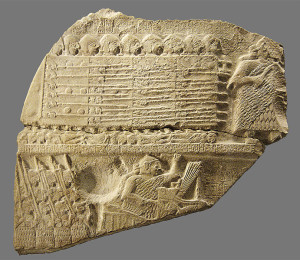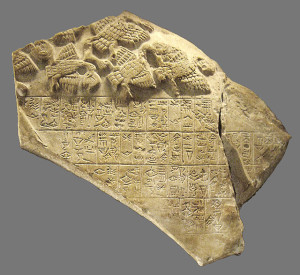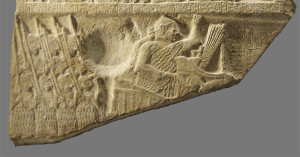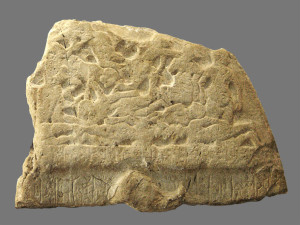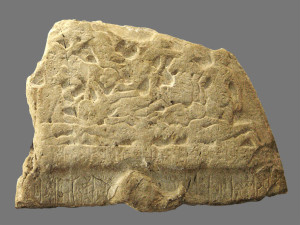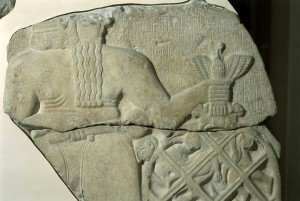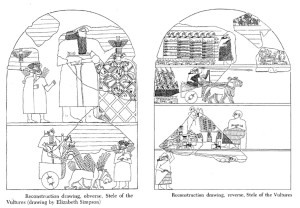EANNATUM and THE STELE OF VULTURES
Who’s Eannatum:
He’s a ruler of the I Dynasty of Lagash.
- Predecessor: Akurgal
- Successor: Enannatum I
Historical Period:
We can place the I Dynasty of Lagash into the chronological period of Early Dynastic III (2450 – 2340 BC)
Stele of Vultures:
- Limestone
- H. 180 cm
- W. 130 cm
- Th. 11 cm
Eannatum, the ensi of Lagash, leads undoubtedly a policy of territorial expansion, specially against the cities of Kish and Umma, as the Stele’s fragments testify. Today, these pieces are preserved in the Louvre Museum, in Paris.
The first fragments of the Stele were brought to light from Ernest de Serzec, in the site of Telloh, the ancient city of Girsu, during the first French archaeological excavations in 1881.
The Stele is made by two sides, both sculpted and inscribed with a long and intricate text written in the sumerian language.
On the first face, there is a large male figure: scholars interpreted this character as Ningirsu, the most important god of the city of Girsu. In one of his hand, he helds a club which he’s using to strike the head of one of his enemies into the net, meanwhile, with the other hand, he grasps the lion-headed eagle AN.ZU. It seems that the eagle itself is holding really closed the net with all the enemies inside. In one of the fragments, we can see a female character: she can be the goddess Ninḫursag, Ningirsu mother.
The second face is the more “hystorical” side: it’s divided into several registers. On the top of the Stele, there are vultures cutting the bodies of dead enemies and feeding with these. Next, we have a first register which shows a battle scene: soldiers are walking on the bodies of enemies. In the second register, some soldiers are marching as in a victory parade: they are following the chariot of their victorious king, Eannatum. The third register shows people burying the bodies of dead people (maybe their enemies) and the usual funeral cerimonies. In the last register, which is very damaged, we can see another battle scene.
The purpose of the Stele is to tell the overcoming of Eannatum above his enemies only because of the goodwill and the favour of his gods and goddess: because of them, he became the ruler of Lagash.
EANNATUM e LA STELE DEGLI AVVOLTOI
Chi è Eannatum:
E’ un sovrano della I dinastia di Lagash.
- Predecessore: Akurgal
- Successore: Enannatum I
Periodo storico:
La prima dinastia di Lagash può essere collocata all’interno del Proto-dinastico III (2450 – 2340 ca. a.C.)
La Stele degli Avvoltoi:
- Materiale: calcare
- Altezza: 180 cm
- Larghezza: 130 cm
- Spessore: 11 cm
L’ensi di Lagash Eannatum conduce senza dubbio una politica di espansione territoriale, soprattutto ai danni di Kish e Umma, come testimoniano i frammenti della cosiddetta “Stele degli Avvoltoi”. Oggi questi sono conservati all’interno del Museo del Louvre, a Parigi.
I primi frammenti vennero portati alla luce da Ernest de Serzec nel sito di Tello, l’antica Girsu, durante i primi scavi archeologici francesi nel 1881.
La Stele è composta da due facce scolpite da bassorilievi e da un lungo e complesso testo in lingua sumera.
Su una prima faccia, è rappresentato un personaggio di grandi dimensioni: è stato interpretato come Ningirsu, il dio poliade della città di Girsu. Egli impugna con una mano una mazza con la quale colpisce la testa di un nemico imprigionato nella rete, mentre con l’altra stringe l’aquila leontocefala AN.ZU (animale mitologico legato alla divinità stessa). Sembra che sia la stessa aquila a serrare la rete che tiene imprigionati i nemici. In un frammento è visibile una figura femminile: essa è stata interpretata come la dea Ninḫursag, madre di Ningirsu.
Sulla seconda faccia abbiamo il lato considerato più “storico”: esso è diviso in più registri. In alto sono presenti figure di avvoltoi che si contendono i corpi dei nemici morti. Successivamente abbiamo un primo registro che rappresenta una scena di battaglia, con una falange di soldati che calpesta i corpi dei nemici. Nel secondo registro sono raffigurati soldati in marcia che seguono il carro del vittorioso re Eannatum. Nel terzo registro abbiamo la tumulazione dei corpi dei defunti, davanti ai quali avvengono i consueti rituali funebri. In un ultimo, frammentario, quarto registro, è visibile un’ulteriore scena di battaglia.
All’interno della stele, viene diffusamente narrato il trionfo di Eannatum sui nemici unicamente grazie alla benevolenza delle divinità dalle quali ha ricevuto la regalità su Lagash.
“Il dio Ninigirsu pose il seme di Eannatum nel grembo della dea Ninḫursag; Ninḫursag lo partorì. In Eannatum, Ninḫursag si rallegrò. La dea Inanna lo prese per le braccia; ella lo chiamò con questo nome…”
